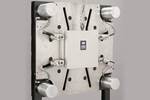Hydraulic Locking Cylinders Offer Faster Mold Builds With Zero Flash Performance
Off-the-shelf Kor-Lok “mini” model 70 and other side action systems by PFA come in more stocking options and next-day delivery to accelerate mold production.
PFA Inc.’s new 70 series “mini” hydraulic locking core pull cylinder, part of the Kor-Lok side action system product line for faster mold builds, is driving more standard strokes for off-the-shelf assembly and next-day delivery.
“We are raising the bar with more stocking options to support increased demand for shorter strokes on the Kor-Lok ‘mini’ model 70 and are extending that to other sizes,” PFA vice president Mark Scanlan says. “PFA still provides any stroke desired, but we are offering additional stock strokes to accelerate mold production for our customers.” Stock strokes for models KL-70/75/100/112 are 0.38", 0.50", 0.63", 0.75", 1.0", 1.25", 1.50", 1.75", 2.0", 2.25", 2.5", 3.0", 3.5", 4.0" and 5.0".
PFA cylinders feature large preloading capacity for zero flash performance in a small footprint. The product line’s primary advantages are high output force, locked-in preloading and a narrow cylinder profile. The mini’s 8,000 lbs of preload activates force in a new narrow format, enabling multiple small cores to nest together and time independently. Smaller ports and low-profile sensors ensure a large competitive advantage to standard compact hydraulic cylinders, according to the company. Zero psi locking also supports green technologies that save energy by dropping hydraulic pressure during injection or stopping core pull pumps after core set.
Customizable parametric online CAD files in more than 100+ native file formats available online. Contact PFA for free application reviews.
Related Content
-
Fundamentals of Designing the Optimal Cooling System
The right mold components can help improve mold cooling and thereby produce higher-quality parts.
-
The Benefits of Hand Scraping
Accuracy and flatness are two benefits of hand scraping that help improve machine loop stiffness, workpiece surface finish and component geometry.
-
How to Eliminate Chatter
Here are techniques commonly used to combat chatter and guidelines to establish a foundation for optimizing the moldmaking process.












